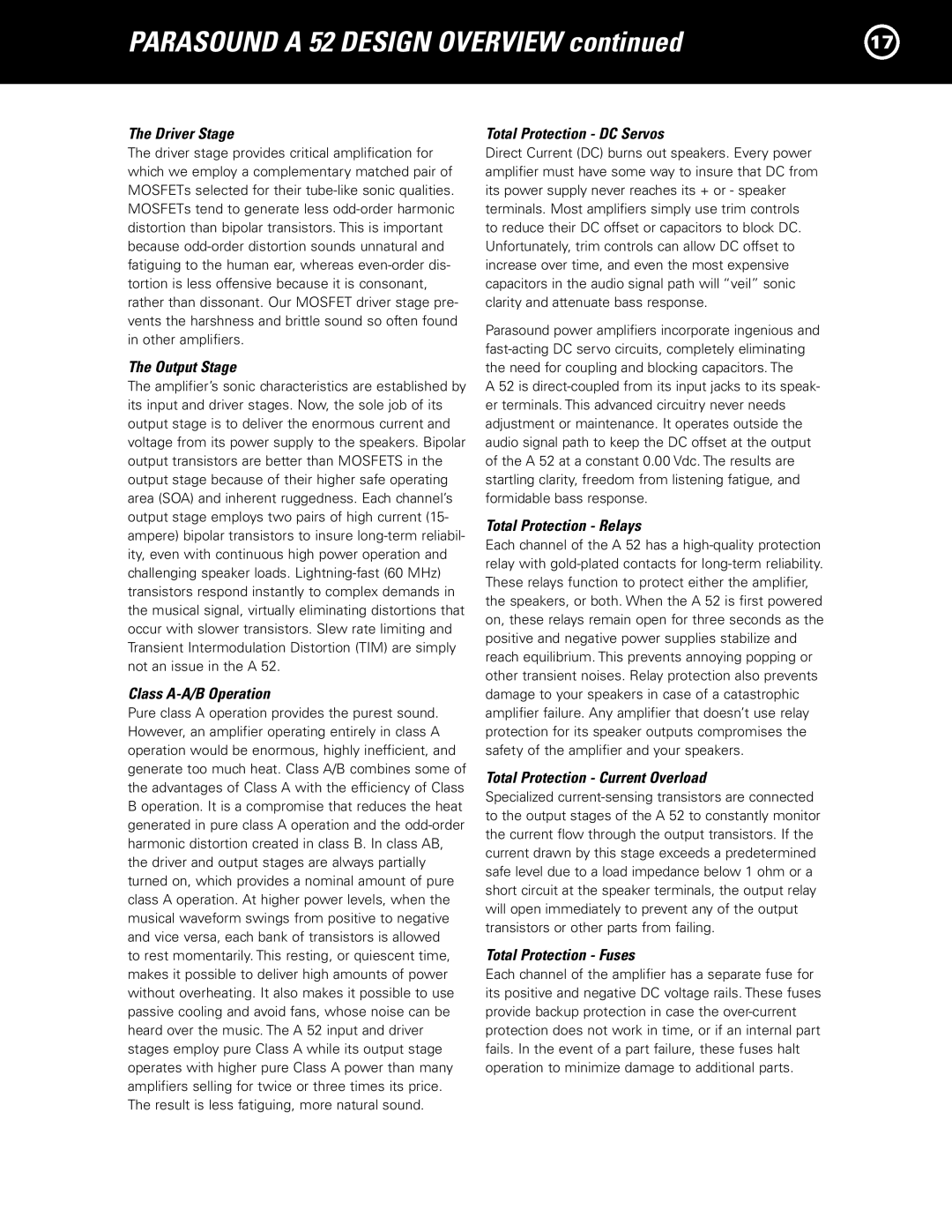The Driver Stage
The driver stage provides critical amplification for which we employ a complementary matched pair of MOSFETs selected for their tube-like sonic qualities. MOSFETs tend to generate less odd-order harmonic distortion than bipolar transistors. This is important because odd-order distortion sounds unnatural and fatiguing to the human ear, whereas even-order dis- tortion is less offensive because it is consonant, rather than dissonant. Our MOSFET driver stage pre- vents the harshness and brittle sound so often found in other amplifiers.
The Output Stage
The amplifier’s sonic characteristics are established by its input and driver stages. Now, the sole job of its output stage is to deliver the enormous current and voltage from its power supply to the speakers. Bipolar output transistors are better than MOSFETS in the output stage because of their higher safe operating area (SOA) and inherent ruggedness. Each channel’s output stage employs two pairs of high current (15- ampere) bipolar transistors to insure long-term reliabil- ity, even with continuous high power operation and challenging speaker loads. Lightning-fast (60 MHz) transistors respond instantly to complex demands in the musical signal, virtually eliminating distortions that occur with slower transistors. Slew rate limiting and Transient Intermodulation Distortion (TIM) are simply not an issue in the A 52.
Class A-A/B Operation
Pure class A operation provides the purest sound. However, an amplifier operating entirely in class A operation would be enormous, highly inefficient, and generate too much heat. Class A/B combines some of the advantages of Class A with the efficiency of Class B operation. It is a compromise that reduces the heat generated in pure class A operation and the odd-order harmonic distortion created in class B. In class AB, the driver and output stages are always partially turned on, which provides a nominal amount of pure class A operation. At higher power levels, when the musical waveform swings from positive to negative and vice versa, each bank of transistors is allowed
to rest momentarily. This resting, or quiescent time, makes it possible to deliver high amounts of power without overheating. It also makes it possible to use passive cooling and avoid fans, whose noise can be heard over the music. The A 52 input and driver stages employ pure Class A while its output stage operates with higher pure Class A power than many amplifiers selling for twice or three times its price. The result is less fatiguing, more natural sound.
Total Protection - DC Servos
Direct Current (DC) burns out speakers. Every power amplifier must have some way to insure that DC from its power supply never reaches its + or - speaker terminals. Most amplifiers simply use trim controls to reduce their DC offset or capacitors to block DC. Unfortunately, trim controls can allow DC offset to increase over time, and even the most expensive capacitors in the audio signal path will “veil” sonic clarity and attenuate bass response.
Parasound power amplifiers incorporate ingenious and fast-acting DC servo circuits, completely eliminating the need for coupling and blocking capacitors. The
A 52 is direct-coupled from its input jacks to its speak- er terminals. This advanced circuitry never needs adjustment or maintenance. It operates outside the audio signal path to keep the DC offset at the output of the A 52 at a constant 0.00 Vdc. The results are startling clarity, freedom from listening fatigue, and formidable bass response.
Total Protection - Relays
Each channel of the A 52 has a high-quality protection relay with gold-plated contacts for long-term reliability. These relays function to protect either the amplifier, the speakers, or both. When the A 52 is first powered on, these relays remain open for three seconds as the positive and negative power supplies stabilize and reach equilibrium. This prevents annoying popping or other transient noises. Relay protection also prevents damage to your speakers in case of a catastrophic amplifier failure. Any amplifier that doesn’t use relay protection for its speaker outputs compromises the safety of the amplifier and your speakers.
Total Protection - Current Overload
Specialized current-sensing transistors are connected to the output stages of the A 52 to constantly monitor the current flow through the output transistors. If the current drawn by this stage exceeds a predetermined safe level due to a load impedance below 1 ohm or a short circuit at the speaker terminals, the output relay will open immediately to prevent any of the output transistors or other parts from failing.
Total Protection - Fuses
Each channel of the amplifier has a separate fuse for its positive and negative DC voltage rails. These fuses provide backup protection in case the over-current protection does not work in time, or if an internal part fails. In the event of a part failure, these fuses halt operation to minimize damage to additional parts.
